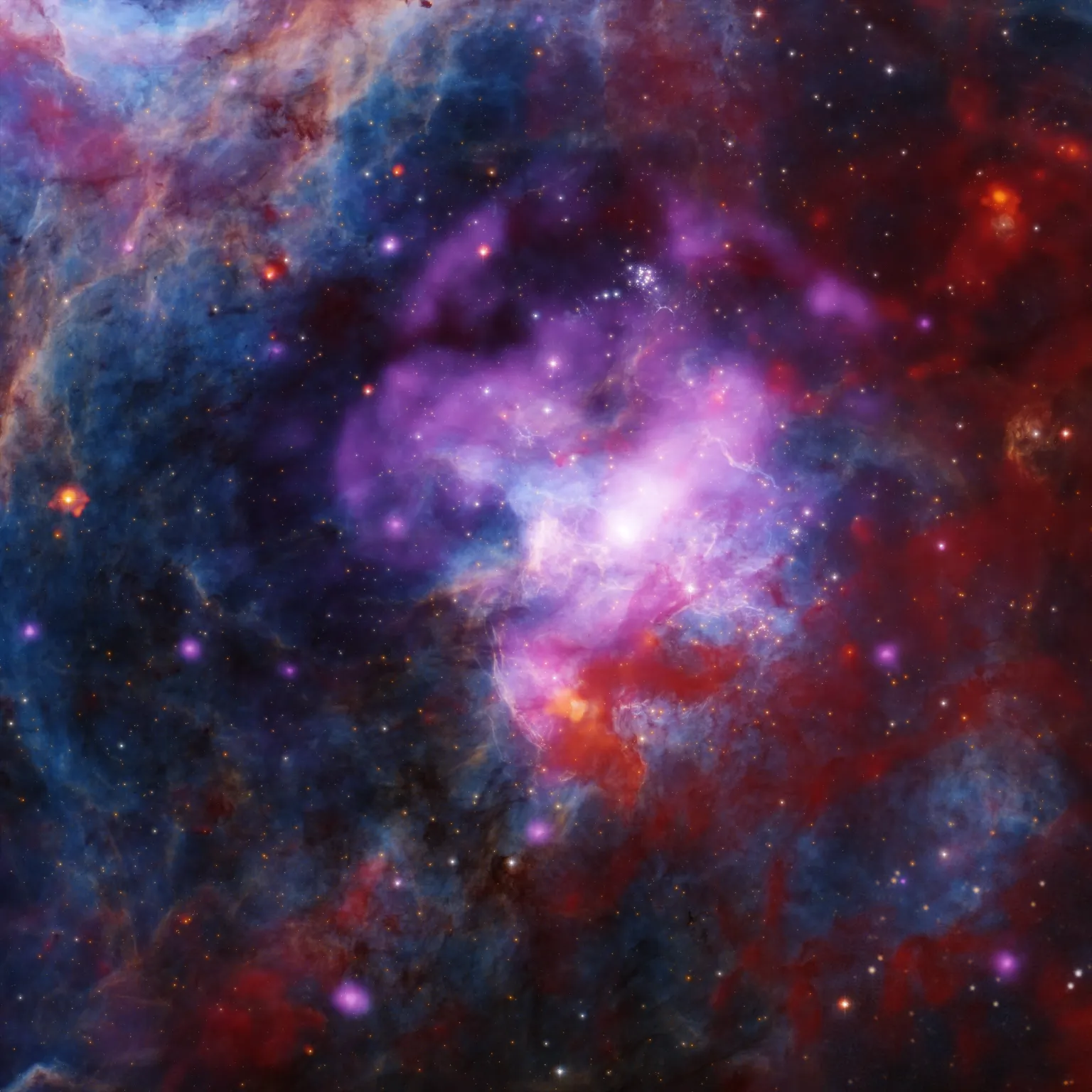The remnants of not one, but at least two exploded stars could be seen in a vibrant, joyful image showing numerous types of light. Star formation has been ongoing in this region of space for the last 8 to 10 million years, and this supernova remnant is called 30 Doradus B, or simply 30 Dor B.
 X-ray: NASA/CXC/Penn State Univ./L. Townsley et al.; Optical: NASA/STScI/HST; Infrared: NASA/JPL/CalTech/SST. Image Credit NASA/CXC/SAO/J. Schmidt, N. Wolk, K. Arcand
X-ray: NASA/CXC/Penn State Univ./L. Townsley et al.; Optical: NASA/STScI/HST; Infrared: NASA/JPL/CalTech/SST. Image Credit NASA/CXC/SAO/J. Schmidt, N. Wolk, K. Arcand
The Large Magellanic Cloud, a tiny satellite galaxy of the Milky Way, is home to a complex landscape of black clouds of gas, nascent stars, high-energy shocks, and superheated plasma, situated 160,000 light-years from Earth.
X-ray data from NASA’s Chandra X-Ray Observatory (purple), optical data from the Blanco 4-meter telescope in Chile (orange and cyan), and infrared data from NASA’s Spitzer Space Telescope (red) were combined to create the new image of 30 Dor B. Moreover, black-and-white optical data from NASA’s Hubble Space Telescope was added to the image to accentuate distinct characteristics.
A team of astronomers led by Wei-An Chen from National Taiwan University in Taipei, Taiwan, analyzed the region using over two million seconds of Chandra viewing time of 30 Dor B and the surrounding area. They discovered a weak shell of X-Rays roughly 130 light-years across.
(For reference, the closest star to the Sun is around 4 light-years distant). The Chandra data also shows that 30 Dor B includes winds of particles flying away from a pulsar, forming a pulsar wind nebula.
Combined with information from Hubble and other observatories, the scientists concluded that the observed phenomena could not be explained by a single supernova explosion. The supernova explosion that followed the demise of a huge star some 5,000 years ago is most likely responsible for both the pulsar and the strong X-Rays observed in the core of 30 Dor B.
It is impossible for the larger, fainter X-Ray shell to have come from the same supernova, though. The X-Ray shell was created by another supernova that occurred more than 5,000 years ago, leading astronomers to believe that at least two supernova explosions occurred in 30 Dor B. Additionally, there is a good chance that considerably more has already occurred.
Astronomers might be able to get further insight from this finding regarding the life span of massive stars and the consequences of their supernova explosions.
These findings were detailed in an article that Wei-An Chen and her team recently published in the Astronomical Journal. The study’s co-authors are Bo-An Chen from National Taiwan University and Chuan-Jui Li, You-Hua Chu, Shutaro Ueda, Kuo-Song Wang, and Sheng-Yuan Liu from the Institute of Astronomy and Astrophysics, Academia Sinica, in Taipei, Taiwan.
Chandra program is run by NASA’s Marshall Space Flight Center. Science operations are managed from Cambridge, Massachusetts, by the Chandra X-Ray Center of the Smithsonian Astrophysical Observatory, while flight operations are managed from Burlington, Massachusetts.
Journal Reference:
Chen, W.-A., et. al. (2023) New Insights on 30 Dor B Revealed by High-quality Multiwavelength Observations. Astronomical Journal. doi:10.3847/1538-3881/acff72.